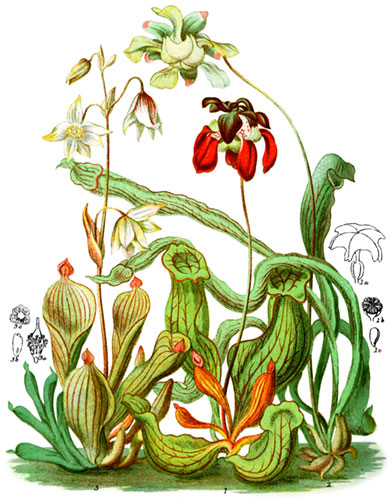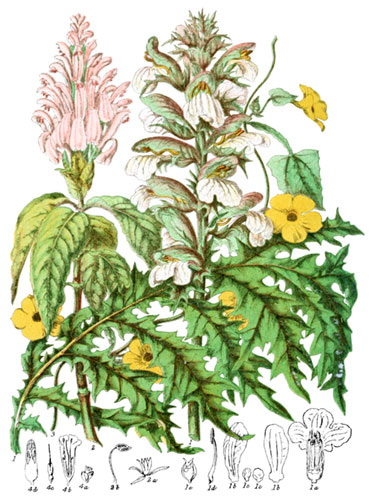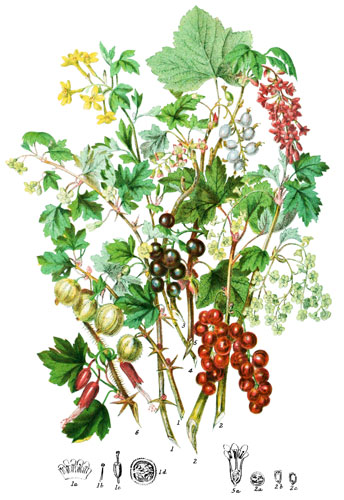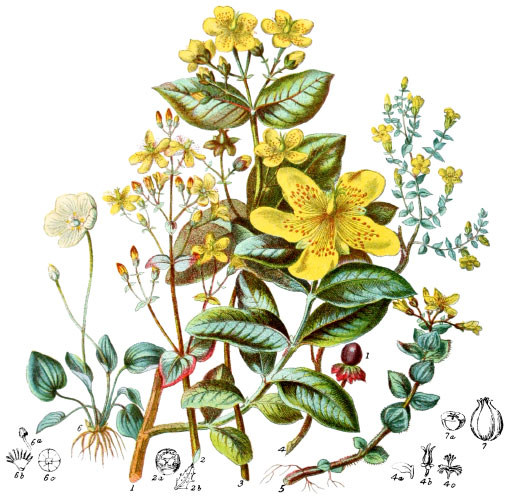Key characteristics
Trees, shrubs, and a few herbaceous plants. The leaves generally opposite, simple, or compound, without stipules, thickly occupied by transparent pores in Myoporum. The flowers are on opposite branches, or on alternate spikes, or from the base of the leaf-stalks, and solitary. The calyx is tubular, five-parted, persistent, placed below the ovary. The corolla is of one petal, tubular, attached below the ovary, generally irregular at the top, sometimes nearly equal, or two-lipped, deciduous. The stamens are usually four, two shorter, seldom equal. The ovary is two or four-celled, the style single, arising from the top of the ovary, the stigma bifid or whole. The fruit is a drupe, a nut, or a berry. The seeds contain a small portion of fleshy albumen, or none.
This Tribe is chiefly distinguished from Lamiaceæ by the concrete ovary, and terminal style, and the general abscence of aromatic pores in the leaves.
Slightly bitter and aromatic properties exist in a few only of these plants.
Select plants in this order
Not all plants listed are illustrated and not all plants illustrated are listed.
- Verbena or Vervain is said to be derived from an old Celtic name.
- V. officinalis (1) was held in high repute in ancient times for various solumn rites and sacrifices by Greeks and Druids, as well as for medicinal purposes, but is now, with many other European herbs, discarded for others from hotter countries generally. It is a common plant by the wayside, but attacts very little notice. This is the only English species, but we find several more in America.
- V. triphylla is remarkable for the extreme fragrance of the leaves, the surface of which is covered with small glands of oil, the delicious scent remaining long after the leaves are dried. The flowers are minute, pale purple, and of no beauty, but the plant is much cultivated on account of the leaves; in Devonshire it flouishes in the open air, and grows to the height of five or six feet.
- V. chamædrifolia (2) is now become one of the most ornamental flowers of the garden, producing abundantly its bright red blossoms until autumn frosts. Several other varieties have been produced by cultivation from South American species; the white flowers of one are very fragrant in the evenint.
- Clerodendron is a genus belonging to the East.
- C. fallax (3) is a beautiful shrub for the conservatory, the leaves sometimes nine or ten inches in length, and the scarlet flowers continuing to come forth for many weeks.
- C. fragrans is very sweet-scented, and the flowers often become double.
- C. deflexum is a shrub on the mountains of Penang.
- Lantana belongs chiefly to the West Indies, but is a frequent inhabittant of our greenhouses; the flowers are usually orange or yellow, some variable in hue.
- L. aculeata (4) is prickly on the lower part of the stem.
- L. macrophylla yields a beverage taken as tea in Brazil; L. pseudo-thea is also thus used: the leaves of other species in Chile contribute to aromatic baths.
- Stachytarpheta is considered in Jamaica as a good substitute for tea.
- Callicarpa (6)* is used to possess aromatic properties in the bark; that of C. lanata is sometimes a substitute for Betel to the Cingalese, and the Malays believe it to have medicinal qualities.
- The most important species in this Tribe is undoubtedly the Tekka of Malabar, the well-known Teak-tree, Tectona grandis. It forms a large and valuable portion of the extensive forests on the mountains of Coromandel, Ceylon, and Java, attains a great size, and yields the most durable timber yet discovered for ships; it contains abundant particles of silex, which renders the texture of the wood extremely hard. The flowers are very small, the leaves are deciduous, large, and covered dwith small rough conical points; the natives obtain from them a useful red dye.
- Gmelina, named after the author of the Flora Sibirica, is a fine evergreen genus of the East Indies; G. arborea (7)† the gumhar of the Hindoos is a large tree with spreading drooping branches, the timber is very hard, though light in weight, and rivals the Teak in durability, being equally secure from the ravages of the Tredo.
- Another remarkable tree belonging to this Tribe is Avicennia tomentosa, named from the famous Persian sage born in the tenth century, now known as the White Mangrove of South America; the first specimen of Tropical vegetation that greeted Humboldt when he landed on the coast of Cumana. These singular trees flourish best in salt swamps, and are found on the margins of all the Indian estuaries; like Rhizophora, stretching out long creeping roots over the mud. The seeds have also the remarkable vitality which causes them to germinate before the fruit falls; the tender leaves and roots of the young plant may be often seen piercing the fruit whilst still on the tree. In shape and size the fruit nearly resembles the almond. The bark is employed for tanning, and a resinous substance which exudes was formerly eaten by the natives of New Zealand.
- The drupaceous fruit of Premna esculenta and others are eatable; but some are very acrid, as that of Vitex trifolia, the Wild Pepper of India.
Locations
This Tribe is common in the Tropics, and in the Temperate regions of South America; rare in Europe, Northrn Asia, and North America. In the Tropics it is developed in large trees and shrubs, in cooler climates the species are herbaceous. Myoporum belongs chiefly to Australia.
Legend
- Verbena officinalis, Common Vervain. England.
- Verbena chamædrifolia, Germander-leaved Verbena. Buenos Ayres.
- Section of Flower.
- Ovary and Pistil.
- Calyx and Bract.
- Stamens.
- Clerodendrum fallax, Scarlet Clerodendrum. East Indies.
- Lantana aculeata, Prickly Lantana. West Indies.
- Myoporum parvifolium, Small-leaved Myoporum. New Holland.
- Seed-vessel.
-
- Fruit of Callicarpa.
- Seed-vessel.
-
- Fruit of Gmelina arborea.
- Section of Fruit.
- *6 was mentioned in the original description but only 6a and 6b were illustrated.
- †7 was mentioned in the original description but only 7a and 7b were illustrated.
Explore more
Posters
Decorate your walls with colorful detailed posters based on Elizabeth Twining’s beautiful two-volume set from 1868.
Puzzles
Challenge yourself or someone else to assemble a puzzle of all 160 botanical illustrations.





